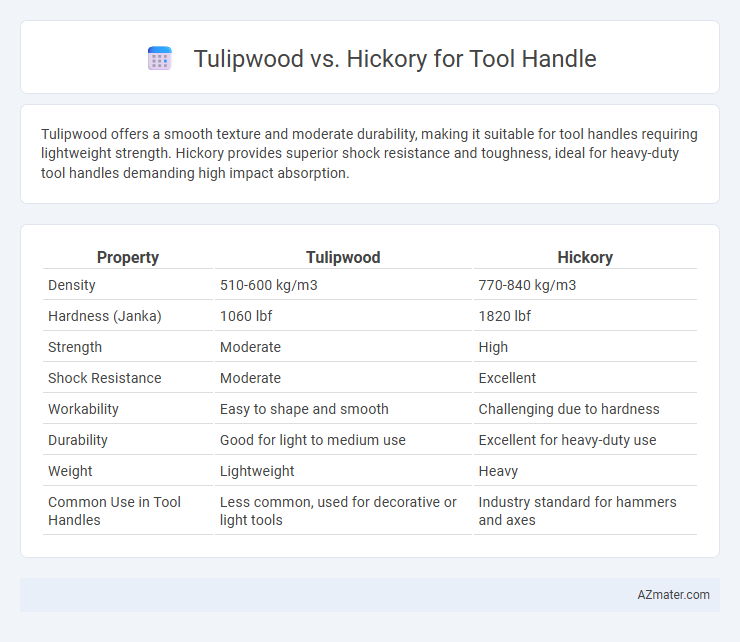Tulipwood offers a smooth texture and moderate durability, making it suitable for tool handles requiring lightweight strength. Hickory provides superior shock resistance and toughness, ideal for heavy-duty tool handles demanding high impact absorption.
Table of Comparison
| Property | Tulipwood | Hickory |
|---|---|---|
| Density | 510-600 kg/m3 | 770-840 kg/m3 |
| Hardness (Janka) | 1060 lbf | 1820 lbf |
| Strength | Moderate | High |
| Shock Resistance | Moderate | Excellent |
| Workability | Easy to shape and smooth | Challenging due to hardness |
| Durability | Good for light to medium use | Excellent for heavy-duty use |
| Weight | Lightweight | Heavy |
| Common Use in Tool Handles | Less common, used for decorative or light tools | Industry standard for hammers and axes |
Introduction to Tulipwood and Hickory
Tulipwood and Hickory are popular choices for tool handles, known for their durability and strength. Tulipwood offers a lightweight feel with fine grain patterns, making it easy to shape while maintaining resilience. Hickory boasts exceptional toughness and shock resistance, often preferred for heavy-duty applications due to its dense, strong fibers.
Physical Properties Comparison
Tulipwood offers a moderate Janka hardness of approximately 1,200 lbf, providing a balance of strength and ease of shaping, while Hickory boasts a significantly higher hardness around 1,820 lbf, making it exceptionally durable and resistant to wear. Tulipwood has a lower density, roughly 560 kg/m3, contributing to lighter tool handles, whereas Hickory's density near 800 kg/m3 results in heavier handles that absorb shock well. The stiffness of Hickory, measured by a high modulus of elasticity (around 12.4 GPa), surpasses that of Tulipwood (about 9.8 GPa), enhancing its impact resistance and longevity in demanding hand tool applications.
Strength and Durability
Tulipwood offers moderate strength and durability, making it suitable for lightweight tool handles but less ideal for heavy-duty use. Hickory is renowned for its exceptional toughness, shock resistance, and long-lasting durability, preferred for demanding tool handle applications. Hickory's higher density and interlocking grain provide superior impact absorption compared to tulipwood's softer and less dense structure.
Workability and Ease of Shaping
Tulipwood offers excellent workability owing to its fine, straight grain and moderate hardness, making it easier to shape and sand compared to Hickory. Hickory, known for its exceptional strength and toughness, presents more resistance during shaping tasks but provides superior durability for tool handles. Choosing Tulipwood simplifies crafting and finishing processes, while Hickory demands more effort but ensures long-lasting performance.
Shock Absorption Capabilities
Tulipwood exhibits moderate shock absorption, providing a comfortable grip with relatively low vibration transfer during tool use, making it suitable for lightweight handles. Hickory is renowned for exceptional shock absorption and high impact resistance, reducing user fatigue and minimizing hand strain in heavy-duty tool applications. The superior density and flexibility of hickory fibers absorb more shock than tulipwood, making it the preferred choice for tool handles requiring durability and comfort.
Resistance to Wear and Tear
Tulipwood offers moderate resistance to wear and tear, making it a lightweight option for tool handles but less durable under heavy use. Hickory is renowned for its superior toughness and excellent impact resistance, providing exceptional durability and longevity in demanding applications. Tool handles made from hickory withstand repeated stress and abrasion much better than those made from tulipwood.
Cost and Availability
Tulipwood typically offers a lower cost and higher availability compared to hickory, making it a budget-friendly option for tool handles. Hickory, valued for its exceptional strength and shock resistance, tends to be more expensive and less readily available due to its slower growth and higher demand. Choosing between the two depends on balancing cost efficiency with durability requirements for specific tool applications.
Common Uses in Tool Handles
Tulipwood and hickory are popular choices for tool handles due to their durability and shock resistance. Hickory is highly favored in construction and woodworking tools like hammers, axes, and mauls because of its superior strength and ability to absorb impact. Tulipwood, while less common, is used in lighter tools and specialty handles where a balance of weight and moderate toughness is required.
Environmental Considerations
Tulipwood offers a more sustainable choice for tool handles due to its faster growth rate and greater availability compared to Hickory, which is slower-growing and often harvested from mature hardwood forests. Hickory's denser grain provides exceptional durability but requires longer cultivation periods, impacting forest regeneration rates. Choosing Tulipwood supports responsible forestry practices and reduces environmental impact while maintaining sufficient strength for most hand tools.
Which Wood to Choose for Your Tool Handle
Tulipwood offers a lightweight and smooth texture, making it ideal for tool handles requiring precision and comfort, while Hickory is renowned for its exceptional strength and shock resistance, suitable for heavy-duty applications. Choosing between Tulipwood and Hickory depends on the tool's intended use: Tulipwood excels in light to medium tools needing finesse, whereas Hickory withstands rigorous impact and prolonged use. For durable, reliable tool handles, Hickory outperforms in toughness, but Tulipwood is a preferred choice when weight and handling agility are priorities.

Infographic: Tulipwood vs Hickory for Tool Handle
 azmater.com
azmater.com